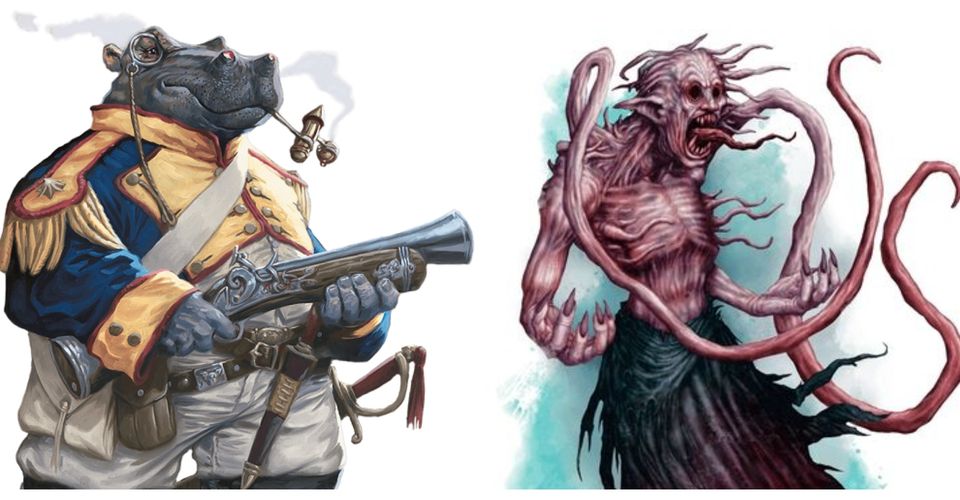D&D: When To Use Homebrew In Campaigns & When To Avoid It

The concept of “homebrew” for Dungeons & Dragons can be a bit difficult to define, but at its broadest it includes any content used for D&D that is not from an official first-party book published by Wizards of the Coast. This means homebrew could include both custom-made content from an individual Dungeon Master for use in their game, or third-party D&D-compatible published products created under the Open Gaming License. Gaming groups should be cautious when it comes to adding homebrew to games, and exercise judgment. A bit of properly used homebrew content can give a campaign a unique flare, but too much homebrew can make a game wildly imbalanced, damage the DM’s intended tone for a campaign, or derail the game entirely.
Homebrewed rules content, including new classes, spells, and other mechanics, are distinct from homemade campaign settings. The official D&DDungeon Master’s Guide provides advice and guidelines for DMs who wish to make their own world, instead of using an official campaign setting like Eberron or Forgotten Realms. This involves a DM creating a map for their original D&D campaign world, determining the details of the cosmology, the nations, the level of technology, and more. Custom-designed campaign worlds are a staple of the D&D experience for many groups, but these games only become truly “homebrew” when they include rules content that is not part of official D&D books.
Dungeons & Dragons was not designed to be a universal tabletop RPG that supports any type of game. It is geared towards heroic fantasy adventures, typically involving overland travel and exploration, delving into trapped and fortified labyrinths, and conflict with mythical monsters, among other things. Most published D&D settings, official and third-party alike, are designed around these assumptions, and provide player characters the opportunity to engage in the kind of heroics that play to D&D’s strengths as a system. Homebrew D&D settings can include video game-based worlds, fantasy novels, or wholly original creations from a group’s Dungeon Master. Each setting is different, and some might require that D&D content be restricted, or new homebrew content be added to reflect the setting’s uniqueness.
Some D&D Homebrew Campaigns Restrict Content & In Others, Anything Goes

Placing restrictions on a game might not seem like homebrew, but taken too far, it can be. Some settings restrict certain races or classes that do not exist in that game world. The Dark Sun setting is a grim D&D world where the gods have perished, so divine D&D classes like Cleric and Paladin are not appropriate for its campaigns. Many settings focus on dictating the rarity of magic, whether it is commonplace and industrialized, like in Eberron, or exceedingly rare. This is fine, and largely still works within the guidelines of D&D, but the game assumes magic is real and present, and this is factored into much of the game’s balance. Running a D&D game in a world entirely without gods or magic severely restricts the available classes and closes off much of the game’s rules and content, as an example of a game where “restrictions” cross the line into homebrew.
Good homebrew choices add setting- or campaign-appropriate content that falls within the established balance of D&D’s existing rules. DMs should take care not to assume that third-party published content is balanced simply because it has been printed or sold digitally, as much of it is wildly unbalanced or would not mesh well with official D&D content. The 5e D&D rules prioritize simplicity and ease of use, but balance is also a major consideration for any game. When weighing whether to use third-party content, whether it is a new class, sub-class, feat, or spell, DMs should compare it with official D&D products. These show what kind of abilities are typically offered at each level and may provide a benchmark as to whether a third-party class is overpowered.
Homebrew backgrounds are easier to gauge, as the rules already allow for generating backgrounds, so long as they provide two trained skills, and a combination of up to two languages or tool proficiencies, along with some sort of useful out-of-combat social or exploration perk. Weighing the balance of homebrew D&D races is slightly more complex. So long as they follow the guidelines laid out in Tasha’s Cauldron of Everything, with either +2 to one stat and +1 to another, or +3 to three different stats, the statistical portion should be acceptable. The DM still needs to weigh whether their other racial abilities have relative parity with those of existing, official races, however.
Unofficial Homebrew Content Begs Scrutiny & Some Is Incompatible With D&D 5e

Judging homebrew Feats and Spells involves a similar paradigm of comparing them against Wizards of the Coast’s published D&D content. A feat that provides a bonus action attack with a specific weapon type might line up with official D&D Feats like Crossbow Expert and Polearm Master, but a Feat that adds an additional attack to the Attack Action is inappropriate, as that overlaps with Extra Attack, a class feature. Understanding the sort of benefits that official races, Feats, and class features provide lets a DM evaluate homebrew content appropriately. When judging homebrew spells, it is easy to spot one that does significantly more damage than official spells of the same level, but DMs should also take care to spot spells that provide significant concentration-free buffs and compare them to the appropriate levels for such spells in official content.
Beyond judging balance for homebrew content, DMs should also ensure it fits within the basic rules of D&D. While some DMs leverage optional rules or house rules to make for memorable campaigns, even these groups should take care that they do not tinker too much with the core rules of the game in their homebrew adventures, as they might be better off using a different system entirely. Restrictive rules in D&D are present for a reason, and something allowing unlimited Reactions, or removing the Concentration limitations for spellcasters, severely damages the balance of the game. Homebrew content that alters the fundamental rules of D&D goes beyond a homebrew addition, and into the realm of a different game altogether.
A bit of homebrew that situationally alters a mechanic may be fine, as many core rules do this. Homebrew that alters fundamental principles of the game entirely – like changing the rubric wherein all light armors allow a character’s full dexterity bonus to AC, while all medium armors are capped at +2, or multiplying static modifiers with critical hits instead of just rolled dice – reflects an entirely different system from 5e D&D, like the third-party rules replacement Level Up: Advanced 5E, which is not compatible with D&D’s rules, only its adventures. DMs can determine whether homebrew content provides situational exceptions, or if it overwrites D&D’s core mechanics. If enough core rules are changed, and the game no longer resembles or functions like official 5e D&D, the group might be better off simply looking to a different tabletop RPG system that is better suited for their campaign.
DMs Should “Reflavor” Existing D&D Classes Before Homebrewing

Though D&D classes and Feats have their own in-fiction descriptions tied to them, sometimes called “flavor text,” groups can separate the rule mechanics of Dungeons & Dragons content from their in-game descriptions, as needed, in their campaigns. Before homebrewing a new race or class, D&D groups should strongly consider “reflavoring” an existing element. A character concept involving a psychic sixth sense, like Spider-Man’s “spider-sense,” does not require a new class or sub-system when it could simply be represented, mechanically, as a Rogue who uses the Cunning Action feature for the Dodge Action routinely and takes the Alert feat to avoid being surprised. Likewise, instead of designing a Hylian race for a D&D campaign in the world of the Zelda games, the Elf race statistics can be used.
The D&D rules are simple and balanced, but the in-fiction “flavor” of classes fits within a particular style of fantasy. Players looking toward more unconventional character archetypes should still look to “reflavoring” existing content instead of homebrew, in most cases. A D&D player trying to simulate a Zangief from Street Fighter-inspired martial artist who delivers devastating suplex takedowns, for instance, might have a difficult time creating a balanced homebrew D&D Monk subclass that interacts with the existing Grab rules in this manner.
Instead, they could simply play a mechanically standard Fighter with the Great Weapon Master feat, and the Battlemaster subclass which enables them to knock enemies prone with attacks, describing their Maul strikes in-game as wrestling moves. Homebrew offers a lot of potential for Dungeons & Dragons games, but if the intent is genuinely to explore new concepts not touched on in the core rules, rather than to break the game’s balance, separating rules from their in-game “flavor” is often a better approach.
About The Author

















